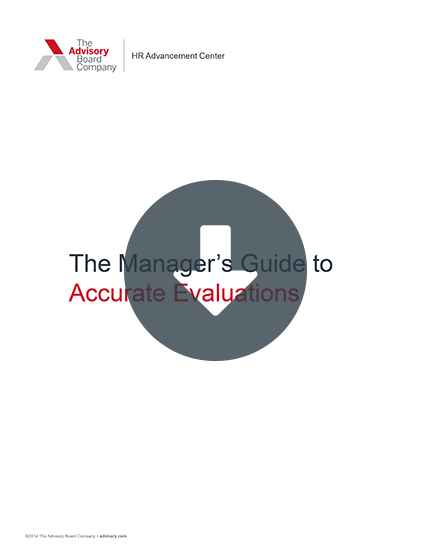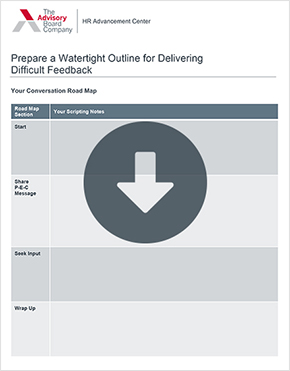Auto logout in seconds.
Continue LogoutMany managers find the performance review process awkward and subjective—which tempts them to give all employees average or high scores.
But inflating ratings sends the wrong message to staff about the purpose of performance management and undermines progress toward organizational goals.
This toolkit includes ready-to-use worksheets, guides, and more to help managers accurately evaluate staff.
Why honest reviews matter
Accurate ratings motivate staff to improve, foster top talent, and enable organizations to fairly link compensation to performance—and they're also personally important to staff. Employees like to know where they stand and tend to appreciate managers who deliver constructive feedback, be it positive or negative.
That's why we've designed a toolkit to help managers home in on the right ratings and deliver effective performance feedback. The resources will help ease the review process—and motivate staff to do their best.
Resources to support the initial review
When managers are ready to start employee assessments, they should keep in mind five essential tips to ensure they're rating fairly. We've compiled these tips into a printable cheat sheet that managers can quickly scan during the review process.
Inevitably, some employees do not meet expectations. When this happens, managers have to deal with one of the hardest parts of performance evaluations—giving bad news to underperformers. This toolkit includes resources to ease these difficult conversations.
Resources to help justify employee ratings
After completing initial evaluations, managers often wonder if their ratings are on target. They may have dozens of direct reports, which makes accuracy difficult, or they may not know how their ratings compare to organizational expectations.
The final section of our toolkit helps managers double-check their ratings, understand how employees perform as a group, and adjust ratings appropriately.
7 tools to help managers rate more accurately
Featured tool: Worksheet for planning tough conversations
Delivering honest feedback just got easier. We’ve created a worksheet that helps managers develop a watertight conversation outline and solidify their talking points before meeting with employees.
First, learn how to use the worksheet. Then, download copies for your team.
Section I: In-the-Moment Support for Employee Evaluations
- Five tips for rating more accurately
- Prepare an outline for delivering difficult feedback
- Pinpoint where and how to change
- Editable worksheet
- Keep difficult performance conversations on track
- Prepare in advance and avoid pitfalls
- Editable worksheet
Section II: Double-Check Your Ratings
- Quick gut-check of staff ratings
- Ensure downward reviews reflect performance
- Editable crosswalk for performance ratings and colors
- Calculate the percentage of your staff rated "high, middle, and low"
- Understand how they perform as a group
- Editable worksheet
- Adjust staff ratings to reflect performance differences
- Ensure direct reports who perform at different levels are rated appropriately
- Editable rating revision worksheet
- Build a case for keeping your rating distribution
- Why your ratings should remain different from organizational targets
- Editable worksheet
Don't miss out on the latest Advisory Board insights
Create your free account to access 1 resource, including the latest research and webinars.
Want access without creating an account?
You have 1 free members-only resource remaining this month.
1 free members-only resources remaining
1 free members-only resources remaining
You've reached your limit of free insights
Become a member to access all of Advisory Board's resources, events, and experts
Never miss out on the latest innovative health care content tailored to you.
Benefits include:
You've reached your limit of free insights
Become a member to access all of Advisory Board's resources, events, and experts
Never miss out on the latest innovative health care content tailored to you.
Benefits include:
This content is available through your Curated Research partnership with Advisory Board. Click on ‘view this resource’ to read the full piece
Email ask@advisory.com to learn more
Click on ‘Become a Member’ to learn about the benefits of a Full-Access partnership with Advisory Board
Never miss out on the latest innovative health care content tailored to you.
Benefits Include:
This is for members only. Learn more.
Click on ‘Become a Member’ to learn about the benefits of a Full-Access partnership with Advisory Board
Never miss out on the latest innovative health care content tailored to you.


